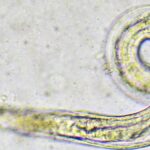Where Do Dog Fleas Come From
Dogs are often considered as man’s best friend. They provide companionship, loyalty, and love to their owners. However, owning a dog also comes with certain responsibilities. One of the most common problems that dog owners face is fleas. Fleas are tiny parasites that feed on the blood of dogs and cause itching, irritation, and even disease. In this article, we will discuss where dog fleas come from and how to prevent them.
What Are Fleas?
Fleas are small, wingless insects that feed on the blood of mammals and birds. They are dark brown in color and measure about 1/8 inch in length. Fleas have an amazing ability to jump up to 7 inches vertically and 13 inches horizontally! This allows them to easily move from one host to another.
Fleas can be found all over the world and there are more than 2,500 species of fleas. However, the most common flea that affects dogs is the Ctenocephalides canis flea.
Where Do Dog Fleas Come From?
Dog fleas can come from a variety of sources. Here are some of the most common ways that dogs get fleas:
1. Other Animals
One way that dogs get fleas is by coming into contact with other animals that have fleas. This can include other dogs, cats, rodents, or wildlife such as raccoons or squirrels.
2. Environment
Dogs can also pick up fleas from their environment. Flea eggs can live in soil for months waiting for a suitable host to come along. When a dog walks through an area where flea eggs or larvae are present, they can easily attach themselves to the dog’s fur.
3. Grooming
Another way that dogs can get fleas is through grooming equipment such as combs or brushes that have been used on an infested animal.
4. Human Contact
Dogs can also get fleas from human contact. Fleas can easily transfer from one person to another if they come into contact with an infested animal.
How Do Fleas Affect Dogs?
Fleas can cause a variety of problems for dogs. Here are some of the most common:
1. Itching and Irritation
Flea bites can cause intense itching and irritation for dogs. This can lead to scratching, biting, and licking which can create sores and hot spots on the skin.
2. Anemia
Flea infestations can lead to anemia in dogs, especially puppies or older dogs with weakened immune systems. Anemia is a condition where there are too few red blood cells in the body, which can cause weakness, lethargy, and even death in severe cases.
3. Disease Transmission
Fleas can transmit diseases to dogs such as tapeworms, Lyme disease, and Rocky Mountain spotted fever.
How Can You Prevent Fleas?
Preventing fleas is much easier than treating an infestation. Here are some tips on how to prevent fleas:
1. Regular Grooming
Regular grooming is essential for preventing fleas on dogs. Brushing your dog’s coat daily will help to remove any eggs or larvae that may be present.
2. Vacuuming
Vacuuming your home regularly will help to remove any flea eggs or larvae that may be present in carpets or upholstery.
3. Professional Pest Control Services
Professional pest control services can help to eliminate any fleas that may be present in your home or yard.
4. Medication
There are many different flea prevention medications available for dogs such as topical treatments, pills, and collars. Talk to your veterinarian about which option is best for your dog.
Conclusion
In conclusion, dog fleas can come from a variety of sources including other animals, the environment, grooming equipment, and human contact. Fleas can cause a variety of problems for dogs including itching, anemia, and disease transmission. Preventing fleas is much easier than treating an infestation and can be done through regular grooming, vacuuming, professional pest control services, and medication. By following these tips, you can help to keep your dog flea-free and happy!



